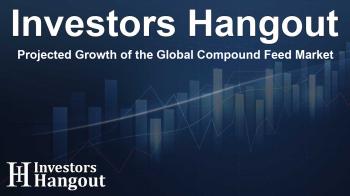Projected Growth of the Global Compound Feed Market

Understanding the Global Compound Feed Market Expansion
The compound feed market is on a growth trajectory, with projections estimating it will reach approximately $668.3 billion by 2028. This sector is gaining momentum due to a significant increase in the global population and an escalating demand for meat, milk, and eggs. With living standards improving, especially in developing regions, the need for high-quality livestock feed is more imperative than ever.
Importance of Compound Feed in Livestock Farming
Compound feed serves as a critical component in animal husbandry, offering a meticulously balanced diet made from a range of ingredients, including cereals, proteins, fats, fiber, vitamins, and minerals. Such formulations aim to maximize livestock productivity and health. By providing balanced nutrition, compound feed enhances not only growth and feed efficiency but also improves the quality of animal products like meat and dairy.
Key Benefits of Compound Feed
Farmers are increasingly adopting compound feed because of several advantages:
- Consistency in Quality: Ensures uniformity in nutrient content, critical for animal health.
- Nutrient Optimization: Tailored for various types of livestock, enhancing growth rates and feed efficiency.
- Cost-Effectiveness: Larger-scale production allows for better pricing and efficiency.
Because of these benefits, compound feed has emerged as an essential element of modern agricultural practices.
Market Segmentation of Compound Feed
The market for compound feed can be segmented based on ingredients, livestock type, and form, revealing various insights about consumer preferences and market dynamics.
Cereal Ingredients Dominate
Cereals, particularly corn and wheat, are a primary source of energy in livestock diets, accounting for the largest market share. Their rich carbohydrate and protein content make them a staple in feed formulations, favored for their affordability and availability.
Poultry Demand Grows
Poultry remains the leading consumer of compound feed, particularly chicken, which is popular globally due to its nutritional benefits and cost efficiency. In recent years, the consumption of poultry has surged, as indicated by significant per capita increases, surpassing other meats like beef and pork.
Mash Feed as a Preferred Form
Mash format is particularly popular for younger and more vulnerable animals, as its fine texture aids in digestibility and nutrient uptake, making it the most prevalent form of feed in the current market.
Rising Trend of Plant-Based Ingredients
With a growing focus on sustainability, plant-based feed formulations are on the rise, offering both eco-friendly solutions and reduced health risks compared to their animal-based counterparts. Ingredients like soybeans complement livestock diets well.
Regional Insights Highlight Asia Pacific's Growth
The Asia Pacific region is leading the growth in the compound feed market. Countries such as China and India are significant contributors due to their increasing populations, growing incomes, and shifting dietary trends towards more animal protein.
Drivers of Market Growth
Several factors are driving the compound feed market:
- Growing Consumption: Demand for meat, milk, and eggs is soaring in many emerging economies.
- Sustainable Alternatives: The need to develop sustainable livestock nutrition solutions is increasingly vital.
- Higher Quality Expectations: Consumers are looking for premium products with superior health benefits.
- Production Efficiency: Standardizing feed production helps reduce costs and improve overall efficiency.
Competitive Landscape
Leading companies in the compound feed market are focused on innovations and sustainable practices. Some major players include:
- Cargill, Inc. (US)
- ADM (US)
- Charoen Pokphand Foods (Thailand)
- New Hope Group (China)
- Land O’Lakes (US)
- Nutreco N.V. (Netherlands)
- Alltech, Inc. (US)
These companies play pivotal roles in advancing the sector through innovation, ensuring they meet the rising demand for high-quality, sustainable feed solutions.
Future of the Compound Feed Market
The compound feed market is critical not only for livestock production but also for global food security. As it evolves to meet the challenges of sustainability while satisfying the growing appetite for animal protein, compound feed remains at the forefront of agricultural advancements.
Frequently Asked Questions
What is the compound feed market size projected for 2028?
The compound feed market is expected to reach approximately $668.3 billion by 2028.
Which region is leading the growth in the compound feed market?
Asia Pacific is both the largest and the fastest-growing region in the compound feed market.
Why is compound feed important for livestock?
It provides nutritionally balanced diets that enhance productivity and health in livestock.
What are the leading types of ingredients in compound feed?
Cereals like corn and wheat are the dominant ingredients in compound feed formulations.
Who are the major players in the compound feed industry?
Key players include Cargill, Inc., ADM, and Charoen Pokphand Foods, among others.
About The Author
Contact Thomas Cooper privately here. Or send an email with ATTN: Thomas Cooper as the subject to contact@investorshangout.com.
About Investors Hangout
Investors Hangout is a leading online stock forum for financial discussion and learning, offering a wide range of free tools and resources. It draws in traders of all levels, who exchange market knowledge, investigate trading tactics, and keep an eye on industry developments in real time. Featuring financial articles, stock message boards, quotes, charts, company profiles, and live news updates. Through cooperative learning and a wealth of informational resources, it helps users from novices creating their first portfolios to experts honing their techniques. Join Investors Hangout today: https://investorshangout.com/
The content of this article is based on factual, publicly available information and does not represent legal, financial, or investment advice. Investors Hangout does not offer financial advice, and the author is not a licensed financial advisor. Consult a qualified advisor before making any financial or investment decisions based on this article. This article should not be considered advice to purchase, sell, or hold any securities or other investments. If any of the material provided here is inaccurate, please contact us for corrections.

